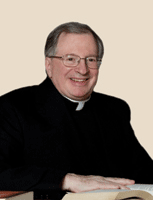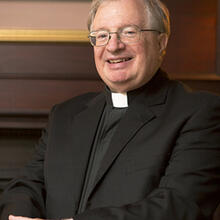As I made my way to the altar, I had to tread carefully through the pilgrims crowded about on the grotto floor kissing the ground where the newborn Jesus is said to have lain. I set down the chalice, checked the Sacramentary and took a step back. The people had suddenly vanished. Later in the sacristy I asked Joe Donnelly, my good friend and guide, “What happened to the people?” “Oh,” Joe said, “the Franciscans take their lunch very seriously.” Joe meant the Franciscans had cleared the chapel of pilgrims for a midday break.
I am ashamed to say that is my most vivid memory from my many pilgrim visits to the Church of the Nativity in Bethlehem. On other occasions, I should add, Joe and I, with other pilgrims, enjoyed the Franciscans’ midday table at their pilgrim hostels across the Holy Land.
At other times we celebrated Mass in the St. Jerome’s chapel, a cave adjacent to the Nativity Grotto. I confess to far greater consolation during those Masses than in the two or three I have celebrated in the central holy site. My feelings, I think, reveal an aesthetic preference in spirituality. For Eastern Christians, the marble floors and walls, the brocade hangings and multicolored oil lamps that decorate the Grotto of the Nativity are the regal tribute due to the King of Kings. For me as a Westerner, however, the rough rock walls of the cave of St. Jerome’s chapel evoke the primitive conditions of Jesus’ birth.
Experts point out that Eastern pilgrims experience the Holy Land in sacramental terms. Their visits are for them a participation in the divine liturgy of the heavenly Jerusalem. One only has to peek into the Catholicon, the Greek Orthodox cathedral at the center of the Church of the Holy Sepulcher, as gold encrusted as the most magnificent throne room, to appreciate how different the Eastern Christian sensibility is from the historical interest of the West.
I find it hard to imagine Eastern Christians trudging down the dusty road from the summit of Mount Tabor to the plain below or taking a meditative sail on the Sea of Galilee. For them it is celebrating liturgy in the holy places that puts them in touch with the divine mysteries. Western pilgrims, by contrast, tend to visit the holy places with a desire to touch the living history of the Holy Land. Like St. Francis of Assisi and St. Ignatius Loyola, they seek to identify with the experience of Jesus by experiencing for themselves the places where he lived.
The terrain of Israel and Palestine is pockmarked with caves. In Nazareth, one can see what a first-century Palestinian village built from caves might have been like. Outside the Basilica of the Annunciation, an opening in the floor of the baptistry allows one to look down on the excavation of a first-century street. Just up the hill, beneath the Church of Saint Joseph, pilgrims can visit a cave-home with its cisterns and rock-hewn olive and wine presses.
It was not in Nazareth, but near Bethlehem at Shepherds’ Fields, that I learned to appreciate what taking shelter in a cave might have been like for the Holy Family. There, in a rather deep cave, a friar explained how shepherds would move their flocks to the back of the cave, build a fire at the mouth where the smoke could escape, and then, nestled in between, find warmth. Suddenly, all those Christmas images of caves, livestock, shepherd boys and herdsmen surrounding the Holy Family came alive. They were not just part of a fanciful artistic tradition. Instead, the rustic images put us in touch with the historical condition of the Holy Family.
I cannot recommend enthusiastically enough taking a pilgrimage to the Holy Land and reading for yourself the “Fifth Gospel” found in the land itself. You might even see a young Arab mother sitting side-saddle on a donkey led by an old man dressed in a dusty gown and kaffiyeh, as I once did in southern Jordan. But if this Christmas you cannot travel there, when you set up your crèche or pray before the Infant in the crib, like St. Francis, who himself had been a pilgrim and who began the custom of the Christmas crèche, know that the figures do indeed put you in touch with the history of Jesus. What matters most, however, is whether the history draws us to share in Christ’s identification with the poor and afflicted.








